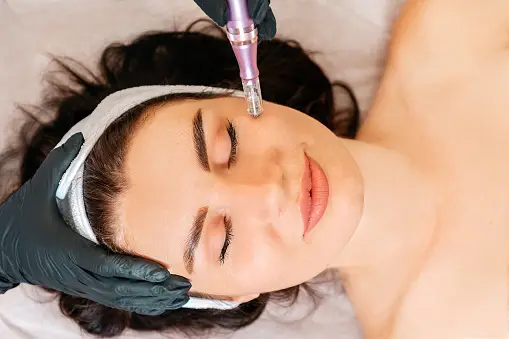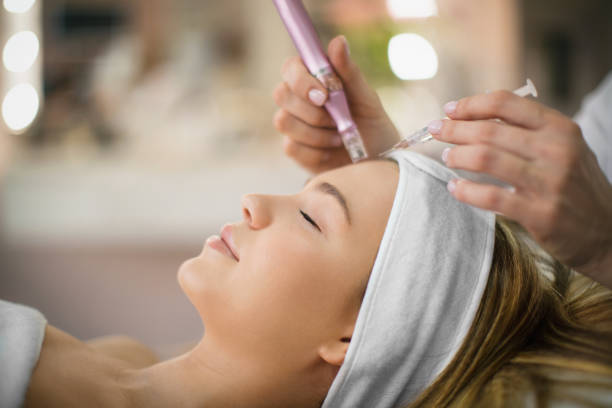Microneedling is a cosmetic procedure that involves puncturing the skin with small, sterile needles to induce collagen production and improve the skin’s appearance. While it can be effective for various skin concerns such as fine lines, wrinkles, acne scars, and overall skin texture, the best age to start microneedling depends on individual factors and skin conditions.
In general, microneedling is typically recommended for individuals who are at least in their late teens or early twenties and have concerns such as acne scars or early signs of aging. However, it’s essential to consult with a dermatologist or skincare professional to determine if microneedling is suitable for your skin type, condition, and age.
Starting microneedling too early, such as during the teenage years, may not be appropriate as the skin is still developing and may be more sensitive. Additionally, it’s crucial to ensure that any underlying skin conditions, such as acne, are under control before undergoing microneedling.
Ultimately, the decision to start microneedling should be made in consultation with a qualified skincare professional who can assess your individual needs and provide personalized recommendations.

Can I use vitamin C after microneedling?
Using vitamin C after microneedling can be beneficial for your skin. Microneedling creates micro-injuries in the skin, which can enhance the absorption of topical products. Vitamin C is a potent antioxidant that can help promote collagen production, brighten the skin, and protect it from environmental damage.
However, it’s essential to be cautious when incorporating products, including vitamin C, after microneedling, as the skin may be more sensitive and prone to irritation. Here are some tips for using vitamin C after microneedling:
- Wait for the right time: Give your skin some time to recover after microneedling before applying any products. Your skincare professional will typically provide guidance on when it’s safe to resume your regular skincare routine, which may be within a few hours to a day after the procedure.
- Choose the right formulation: Opt for a gentle and non-irritating vitamin C serum specifically formulated for sensitive skin or post-procedure use. Look for serums with a lower concentration of vitamin C (around 10-20%) to minimize the risk of irritation.
- Patch test: Before applying vitamin C to your entire face, perform a patch test on a small area of skin to check for any adverse reactions or irritation.
- Apply gently: Be gentle when applying vitamin C serum to your skin after microneedling. Avoid rubbing or tugging on the skin and use a light patting motion to apply the product.
- Moisturize and protect: After applying vitamin C serum, follow up with a moisturizer to help hydrate the skin and a broad-spectrum sunscreen to protect it from UV damage.
- Follow post-care instructions: Your skincare professional may provide specific post-care instructions, including which products to use and how to care for your skin after microneedling. Follow these instructions carefully to ensure optimal results and minimize the risk of complications.
If you experience any persistent irritation, redness, or discomfort after using vitamin C or any other skincare products following microneedling, discontinue use and consult your skincare professional for further guidance.
Microneedling and Botox are two different cosmetic treatments that address different concerns and work in different ways. Therefore, it’s not accurate to say that one is inherently “better” than the other, as their effectiveness depends on individual goals, preferences, and specific skin concerns.
Here’s a comparison of microneedling and Botox:
- Microneedling:
- Procedure: Microneedling involves creating controlled micro-injuries in the skin using fine needles to stimulate collagen production and improve the skin’s texture and appearance.
- Benefits: Microneedling can help reduce the appearance of fine lines, wrinkles, acne scars, enlarged pores, and uneven skin tone. It can also enhance the absorption of topical skincare products.
- Results: Results from microneedling typically develop gradually over several weeks to months as collagen production increases. Multiple sessions are usually recommended for optimal results.
- Downtime: There may be some redness, swelling, and mild discomfort after microneedling, but downtime is generally minimal compared to more invasive procedures.
- Botox:
- Procedure: Botox, or botulinum toxin, is injected into specific facial muscles to temporarily relax them and reduce the appearance of wrinkles and fine lines caused by repetitive muscle movements.
- Benefits: Botox is primarily used to treat dynamic wrinkles, such as forehead lines, frown lines, and crow’s feet, that result from facial expressions. It can also be used for preventative purposes to delay the onset of wrinkles.
- Results: Botox results are typically noticeable within a few days after treatment and can last for several months. Maintenance treatments are required to sustain the effects.
- Downtime: There may be some minor swelling or bruising at the injection sites, but downtime is minimal, and patients can typically resume normal activities immediately after treatment.
Ultimately, the choice between microneedling and Botox depends on your specific concerns, desired results, and preferences. Some individuals may benefit from combining both treatments to address multiple aspects of skin aging comprehensively. It’s essential to consult with a qualified dermatologist or skincare professional to determine the most suitable treatment plan for your needs.
